As Edwin van Cleef is getting ready to pack his belongings before being booted out of Standard, burdened by that extra mana cost, it’s worth noting how he’s only the second of the original class legendaries to bite the dust. Indeed, a look back at the gang of nine serves as both an interesting trip down memory lane and a useful set of observations about how Hearthstone and its card design changed over the years.
Who Dares Defile This Ancient Set?
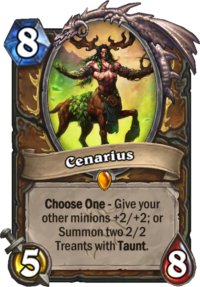
Ah, the good old days when 9/12 worth of stats split across three bodies was a strong enough play on turn nine and possibly even beyond. Like so many Druid cards, it was the flexibility that gave so much extra mileage to Cenarius across the years, doubling as a stabilization tool and a potential finisher as a 9-mana Savage Roar for any wide board.
Neither are really applicable when the gameplan is to deal a gazillion damage from hand with a degenerate combo, and as the card pool keeps expanding, there always seems to be a better specialized card for both the token and the ramp-based archetypes, with no midrange Druid deck to be seen since the good old Force of Nature/Savage Roar days – which was, in many ways, the best kind of deck for this sort of a card.
A Classic Dinosaur Roar

King Krush is a funny card but it’s easy to see why it has limited application. As long as you have to legitimately pay its mana cost – as was the case in the Classic days – it is strictly inferior to something like Ragnaros the Firelord to begin with, not to mention Hunter’s built-in challenges when it comes to constructing a slower deck, requiring aggressive support from specific sets to make them viable in any way.
Still, a gigantic dinosaur to the dome is fun for the whole family – no wonder it’s been repurposed into Dinotamer Brann, even if you have to forgo duplicates for the two mana reduction and the incidental 2/4 body. Without something obscene like Recruit, it’s tough to imagine the king returning to its throne anytime soon.
You Require My Fireballs?

I still remember the first time I ran into Archmage Antonidas. Back in the Classic days, somewhere on the bottom rungs of the ladder as a CCG newbie. It being the lowly part of Ranked and all, my opponent just tossed it out on turn seven.
I was flabbergasted. I had no way to kill it. I was dead soon thereafter.
We probably all have a story like this with the Archmage, and it says a lot about Hearthstone’s origins that this sort of resource generation started off with a seven-mana base cost (plus a playable spell) as an added requirement. (, Whirlkick Master, hello?) Indeed, back when the starting 30 hit points were more of a baseline than just a polite suggestion, even just the incidental Fireball pickup from this card could be good enough for Freeze Mage decks – and it’s no wonder their matchup against Control Warriors were infamously bad, but that’s another story.
As the game got more degenerate over time, the only real way to make use of Archmage Antonidas was to fully kill your opponent with it, courtesy of OTK setups mostly seen in conjunction with Open the Waygate. We hardly saw any such deck in the game as of late, and at this stage it seems quite likely that the Grand Magus of the Kirin Tor will recede from most Mage decks.
Put Your Faith in the Ashbringer

Most of us remember the original “Fiery Win Axe” as the ultimate value card from the time when it used to cost two mana but Tirion Fordring was right behind it in play and win percent metrics for a very long time. Even today, if you squint hard enough, you can see how potent the value proposition is: a decent-sized Taunt that takes two attacks to remove, which then grants a card that either allows you to three-for-one or to push half of your opponent’s total health in damage over the course of three turns.
Interestingly, it still took quite a while for top players to realize just how good this card is even without any initiative – so much so that it sometimes made it into aggressive decks of the past as well – and it’s the general collapse of slower Paladin decks rather than anything else that means we don’t really see Tirion around anymore. The class could never compete with the mass resource generation of other archetypes, which meant that all of its slower decks revolved around spell combos, living no room to an expensive late-game taunt.
Not All Who Wander Are in Standard Anymore
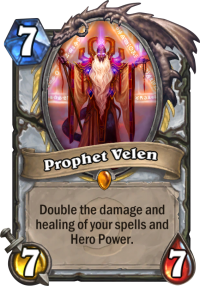
Before Edwin, there was Prophet Velen, a card which oscillated between absolutely useless and game-breaking over the years, which in itself was a good reason for it to move to the Hall of Fame around the time of the Priest class redesign.
Though the bonus heal never really came into play, any time Anduin could set up some sort of damage combo (mostly involving Mind Blast, which was also rotated out of Standard due to a similarly narrow applicability) meant that an OTK was in sight. Most infamously of all, “Razakus Priest” with the 0-mana machine gun hero power from Shadowreaper Anduin was an unstoppable scourge on the meta, so much so that Raza the Chained was specifically nerfed for its implications on Wild gameplay.
Its replacement, Natalie Seline would have been an awesome card back when the game first came out, but just isn’t anywhere near efficient enough when you have so many hard removal options to choose from.
The Endless Combos Shall Prevail
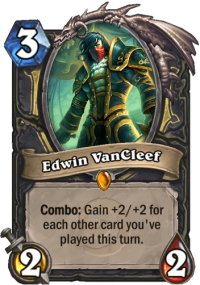
Of course, he of the Brotherhood is the big one to discuss here, and no doubt there will be many other voices added to the conversation. The unspoken issue with Edwin VanCleef is that the card originally carried a risk-versus-reward calculation that is no longer present when playing it.
As strong as a 3 mana 10/10 is, if it comes at a cost of fully exhausting your hand making ancillary plays for little benefit, it’s easy to see how any sort of removal or stall can punish you for it. Nowadays, with much stronger card draw and resource generation options, coupled with the introduction of tools like Lackeys to utilize the mana dumped into Edwin as effectively as possible, the card is just too consistent and its intended downside has ceased to be. When was the last time you saw a Rogue player stuck topdecking their way out of trouble?
Famously, Edwin VanCleef was a part of every single World Championship-winning lineup and arguably every single Rogue archetype with the exception of the original Quest decks with The Caverns Below, which were, of course, even more busted. It is a long overdue change, especially in light of the class’ current card pool in Standard.
WIIIIINDS (And Insects)
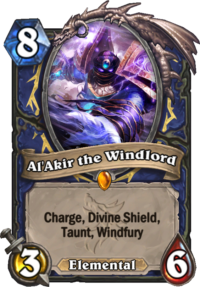
Turns out, a jack of all trades isn’t necessarily a master of none – but it’s been quite a while since Al'Akir the Windlord truly had a chance to shine. Of all the keywords on the legendary, Charge is the one that has been pushed back to most over the course of the game’s development, and a look at something like Zilliax (admittedly a premium card in its own right) shows how not being able to make full use of the chance to go face cripples this card.
In many ways, its regression is similar to what happened to Paladins and Tirion Fordring, but the nerf to its supporting cast certainly had a lot to do with it as well. Most notably, the nerf to Rockbiter Weapon (which originally cost one mana) severely limited its potential as a finisher, and the cleanup duty it offered against token-based decks just no longer does enough in the late game when tools like The Forest's Aid are there to ruin your day as the player on the defensive side.
You Face a Death Knight That Isn’t Quite a Death Knight

Lord Jaraxxus was one of the most unique cards at the time the game launched and forced a special assessment of risk versus reward in slower Warlock decks. If you can survive and stabilize after the swap, nothing could stand up to the endless stream of 2 mana 6/6 Infernals in the long run – but you also left yourself open to a quick killing blow due to the hard cap of fifteen health.
Even a quick look at the Death Knights from the Knights of the Frozen Throne set (and later hero cards) make it clear just how much the Eredar Lord of the Burning Legion has been a victim of its own success in terms of design: the flat plus five Armor instead of the fixed change to fifteen health is a huge deal, not to mention how the equipped 3/8 weapon no longer provides enough initiative for nine mana nowadays, especially in comparison with something like Bloodreaver Gul'dan. It’s tough to see how Lord J could ever return to a Standard meta but it served as a memorable piece of design and an important stepping-stone for future concepts in Hearthstone.
I Can Wait No Longer So Please Enrage Me Quickly K Thx Bye
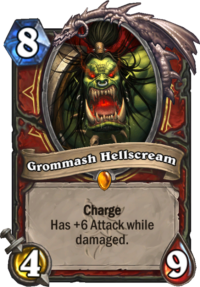
Grommash Hellscream goes face for ten or twelve damage. It’s always been thus. At the end of the day, the card’s application is extremely narrow – you’re never really happy if you’re using it to trade, but at least the option is there. It represents such a significant chunk of SMOrc for relatively little mana investment that it’s always been useful across the years.
Indeed, the notable differences between Shamans’ late game burn bomb and Warriors’ tells us a lot about how important it is to have other reliable source of pressures and flexibility. Warriors have both the better clears and the stronger initiative tools to go on the offensive, and it took a very long time for the class’ late game value bomb cards to reach a critical mass where Grom isn’t an auto-include in its slower decks.
The Game Has Changed
Just because most of the class legendaries got away so far doesn’t mean that the Classic set as a whole survived this kind of scrutiny. Indeed, three of the neutrals were so omnipresent – and therefore limiting design space – that they eventually had to rotate here (Ragnaros the Firelord, Sylvanas Windrunner and Leeroy Jenkins), not to mention the reward cards like Old Murk-Eye, Elite Tauren Chieftain and Gelbin Mekkatorque. There’s no shortage of non-legendaries nerfed or removed from the evergreen set either.
The fact that only two of the original class legendaries had to be adjusted show just how strong those design ideas were, both from a flavor and a gameplay perspective – but the passage of time and the game’s growing power levels also suggest we’re going to see less and less of the likes of Cenarius and Al'Akir the Windlord on the ladder going forward as well, regardless of how the rumored Classic redesign may shake out.

Jaracxus needs a rework to be more useful.
Welp, I’m surprised you don’t include classic neutral legendaries in this article.
I would be interested to see your view on some of them, like Gruul, or The Beast, or them Dragons.
Not every neutral legendary has to be top-tier?
But yeah I remember way back losing to a Hogger and being excited when I got one from a pack
Hahah, I also remember unpacking Hogger back in the Beta, shortly after I started playing. The card looked so OP I put it into every single deck. INFINITE VALUE, amrite? And it actually was working really well back when most people were playing bad homebrew decks. Fun times.